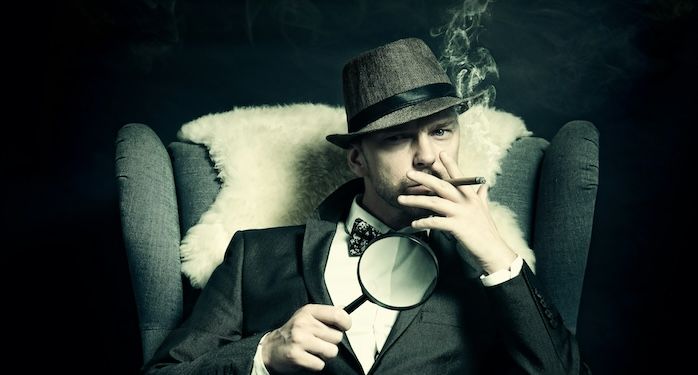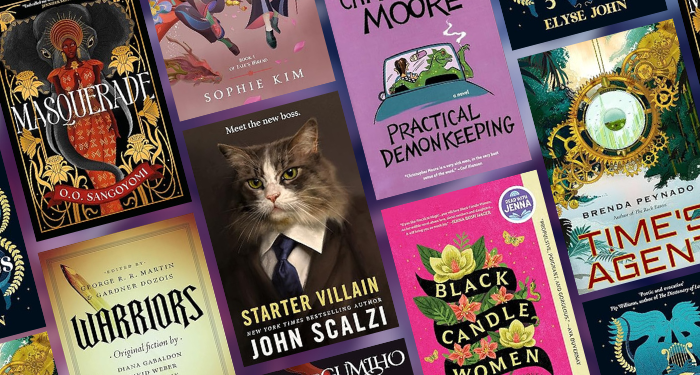By Oscar Mardell.

Sam Mills, The Watermark (Granta, 2024)
Augustus Fate, a wildly popular but reclusive and sadistic novelist, has been shortlisted for the Booker Prize seven times now. Preventing him from actually winning the thing is the fact that his characterisation lacks any real depth or feeling – that it is, in other words, bereft of love. Jaime (‘I love’), a young journo and former Eng Lit major, has won (or, at least, believes that he’s won) a competition to interview Fate, but Jaime’s mind is preoccupied with Rachel, a painter whom he met in an online suicide forum and who’s recently gone radio silent. It soon transpires that Fate has imprisoned Rachel and drugged her with a magical tea. That, and that he staged the competition in order to do the same to Jaime. Fate intends to finally win the Booker by peopling his forthcoming work (a pseudo-Dickensian coming-of-ager called Thomas Turridge) with actual people, and to this end drops both Jaime and Rachel into his fictionalised version of 1860s Oxford.
Almost immediately, things begin to go awry. First, the effects of the tea sometimes wane – and whenever they do, Jaime (who becomes the titular ‘Thomas’) and Rachel (who retains her original name) can hear the voice of Fate’s narration. Second, the two discover that, by means of a slightly different blend of magical tea, they can actually hop between books. Their first detour is into a novel set in Manchester 2014 (or rather, into what its author, whom Fate imprisoned and drugged back in 2007, imagined Manchester might be like in seven years’ time). Next, they sidestep into a Magical Realist work set in Carpathia 1928 (albeit, one featuring ‘yukiri’ – a ‘half-animal, half-instrument, rather like a harp with a bird’s face’). Then they move into some Science Fiction set in a future London where people coexist with autonomous robots (although, not without significant friction). Finally, they return to Thomas Turridge – only, it is half a century later, and eerily glitchy this time. It’s a tremendously fun conceit, the idea that one might ‘inhabit’ a fiction or a sequence of fictions in the same way that one ‘inhabits’ reality. But it also draws attention to the overlap between those two realms: through the five stories at the core of The Watermark, the various constituents of our current, shared reality – selfhood, capital, historical progress, male supremacy, human exceptionalism – are each revealed to be a fictitious construction.
Perhaps the most complex of these components – of the ideas accepted as fact within our own world and myth-busted within The Watermark – is the notion of authorship. On first encountering Jaime, Fate quotes from Nabokov’s 1967 interview for The Paris Review:
It was not [E.M. Forster] who fathered that trite little whimsy about characters getting out of hand; it is as old as the quills, although of course one sympathises with his people if they try to wriggle out of that trip to India or wherever he takes them.
‘Nabokov saw his own characters as galley slaves…’ explains Fate, ‘That is as it should be.’ How, then, should Fate’s own characters free themselves of the sheer authoritarianism of his authorship? Rachel’s first line of approach is to try her hand at being her own author, ‘taking control of the narrative’, as it were, by literally penning her own biography. But the strategy is quickly problematised by a trickier question – one which isn’t posed explicitly in The Watermark but which looms large throughout its pages: ‘Qu’est-ce qu’un auteur?’ as Foucault once put it. ‘What is an Author?’
Instead of simply, say, re-announcing The Death of The Author, The Watermark takes a more original path and posits instead that an author is, well, a sort of watermark. Rachel first touches on the idea (albeit indirectly) whilst discussing the role of the artist, claiming:
A thousand people can paint a tree beautifully, so what makes one particular painting seem that little bit special compared to the masses? It is the consciousness of the artist that makes a painting, the way it hovers in the work like a watermark.
This line of thought is further developed within a later discussion of the merits and pitfalls of robot-creativity: ‘Art has always thrived on biography,’ explains the narration, ‘it exists in every piece like a watermark’. But if it’s the creator’s life-story that makes an artwork ‘that little bit special’ or enables it to ‘thrive’, then what happens when the medium is storytelling? Does it really make sense to say that a good story’s ultimate value lies within another story? With the exception of Celebrity Autobiography, surely the opposite is true? We tend not to be interested in authors’ works because of their lives but in their lives because of their works.
The Watermark navigates this paradox by proposing that we think of the author as a kind of character – not as the story’s creator per se but as one of its components. The first invitation to do so occurs whilst Rachel is contemplating the possibility that she won’t be able to return to her reality, that she’ll cease to be an actual person and will just become a literary character hopping through different novels forever. ‘[H]ere I will stay,’ she mourns, ‘drifting through books as I grow old alone, seeping into these pages like a watermark’. Here, a ‘watermark’ is something which has no real presence but only exists on the page – that is, in fiction. If the ‘consciousness’ or ‘biography’ of the ‘artist’ is also ‘like a watermark’ then the suggestion appears to be that it, too, might exist only in fiction – or, at least, as the product, rather than the source, of the storyteller’s artifice. That authorship is one such ‘watermark’ is eventually confirmed in the final showdown with Fate. I won’t give too much away here; suffice it to say that Jaime and Rachel are only able to defeat Fate – to escape his prisons, to free themselves of his tyranny, and to get on with the romance-plot, the all-important business of being deeply in love with one another – when they pry into the (literal) building blocks of his identity, the very constructedness of his character.
There is, I think, a covert theology in all of this. As Thomas Turridge, Jaime becomes obsessed with the implications of Darwin’s discoveries – specifically, with the possibility of faith and sanctity after the so-called Death of God. In all of her incarnations, Rachel is fascinated by what the Hindu Vedas call samskras: ‘Imprints, impressions, recollections that take root, form habits, conditioning us’. Together, they offer a concept of the divine that is directly analogous to The Watermark’s concept of authorship: on the one hand, the divine here is a fiction, a textual construct, something which only exists on, or as a result of, the page itself; on the other hand, the divine is a sort of watermark, a discernible ‘imprint’ or ‘impression’ which ‘hovers’ in everything that seems ‘that little bit special’. What is this ‘fiction’? This strange ‘impression’? For The Watermark, it is the romance-plot, the all-important business of being deeply in love with one another.
Read a short story by Sam Mills in 3:AM here.

ABOUT THE REVIEWER
Oscar Mardell is a teacher and writer from Tāmaki Makaurau / Auckland. He is the author of Delirious New Lynn, forthcoming from 5ever Books.












 Bengali (Bangladesh) ·
Bengali (Bangladesh) ·  English (United States) ·
English (United States) ·